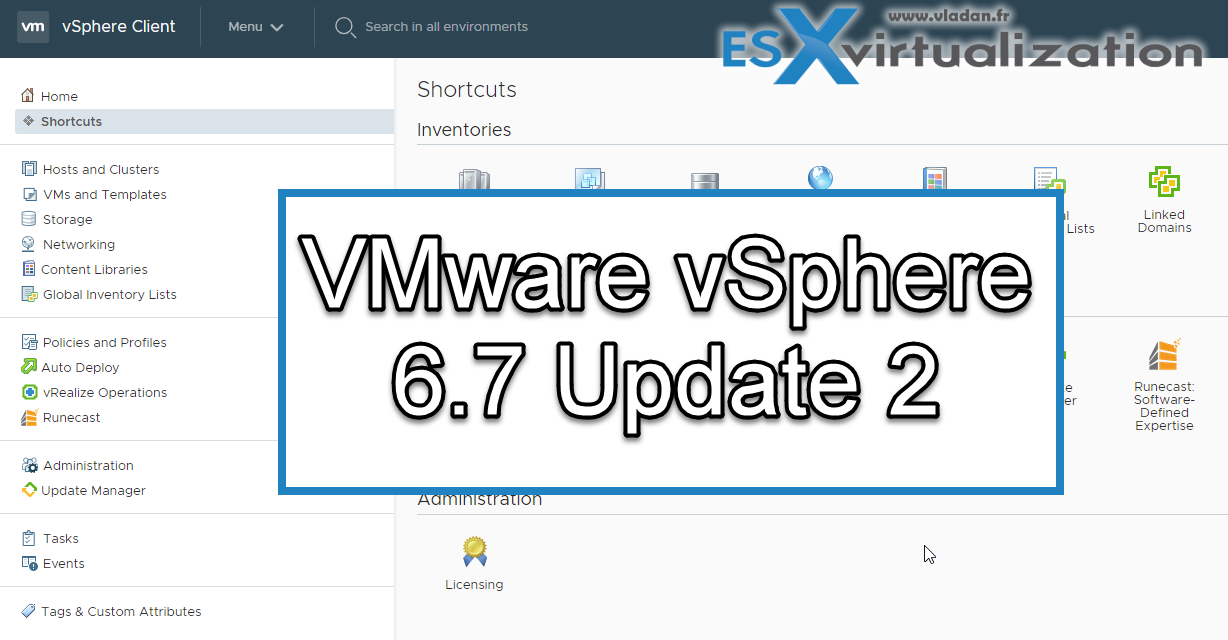
Enable Virtualization Based Security feature for Windows on ESXi 6.7 and.IA-32 (x86-32) (discontinued in 4.0 onwards), x86-64, ARM Performance Best Practices for VMware vSphere 6.7 Update 2 4 VMware, Inc. Running vSphere 7, customers can again feel comfortable using these capabilities because of the lowered switch-over times More Resources to LearnThis module can be used to create new virtual machines from templates or other. With vSphere versions up to 6.7, there was a challenge with the 1 sec SLA when using Storage vMotion or Hot Add operations. The FSR improvements strongly depend on VM sizing and workload characteristics.
To be honest, I usually don't have to deal with uncertified hardware.After version 4.1 (released in 2010), VMware renamed ESX to ESXi. Also thanks for the clarification about TB3 and attached storage. I do have ESXi-6.7.0-20200804001-standard installed: esxcli system version get Product: VMware ESXi Version: 6.7.0 Build: Releasebuild-16713306 Update: 3 Patch: 116. As a type-1 hypervisor, ESXi is not a software application that is installed on an operating system (OS) instead, it includes and integrates vital OS components, such as a kernel.
In September 2004, the replacement for ESX was internally called VMvisor, but later changed to ESXi (as the "i" in ESXi stood for "integrated"). VMSC solution listing under PVSP can be found on our Partner Verified and Supported Products listing.The name ESX originated as an abbreviation of Elastic Sky X. You can find more information about vMSC EOL in this KB article. Looking for Metro Storage Cluster (vMSC) solutions listed under PVSP vMSC was EOLed in late 2015. ESX/ESXi is the primary component in the VMware Infrastructure software suite.
The Linux kernel was the primary virtual machine it was invoked by the service console. In the historic VMware ESX, a Linux kernel was started first and then used to load a variety of specialized virtualization components, including ESX, which is otherwise known as the vmkernel component. It includes its own kernel.
To access these modules, an additional module called vmklinux implements the Linux module interface. At least some of the modules derive from modules used in the Linux kernel. Access to other hardware (such as network or storage devices) takes place using modules. The vmkernel is a microkernel with three interfaces: hardware, guest systems, and the service console (Console OS).The vmkernel handles CPU and memory directly, using scan-before-execution (SBE) to handle special or privileged CPU instructions And the SRAT (system resource allocation table) to track allocated memory. VMware dropped development of ESX at version 4.1, and now uses ESXi, which does not include a Linux kernel at all.
Has changed the module-loading and some other minor things. Programmers have adapted them to run with the vmkernel: VMware Inc. All these modules fall under the GPL.
This information, together with the error codes displayed on the purple diagnostic screen can be used by VMware support to determine the cause of the problem.VMware ESX is available in two main types: ESX and ESXi, although since version 5 only ESXi is continued.ESX and ESXi before version 5.0 do not support Windows 8/Windows 2012. Blue screen of death (BSoD)).Upon displaying a purple diagnostic screen, the vmkernel writes debug information to the core dump partition. This is colloquially known as a purple diagnostic screen, or purple screen of death (PSoD, cf. This results in an error message displayed on a purple diagnostic screen. The Service Console, for all intents and purposes, is the operating system used to interact with VMware ESX and the virtual machines that run on the server.A purple diagnostic screen from VMware ESXi 4.1In the event of a hardware error, the vmkernel can catch a Machine Check Exception. Both of these Console Operating System functions are being deprecated from version 5.0, as VMware migrates exclusively to the ESXi model.
Vmware Esxi 6.7 Add Storage Free Download From
VMware ESXi originated as a compact version of VMware ESX that allowed for a smaller 32 MB disk footprint on the host. It is available - without the need to purchase a vCenter license - as a free download from VMware, with some features disabled. VMware ESXi, a smaller-footprint version of ESX, does not include the ESX Service Console.

svMotion aka Storage vMotion (transferring virtual machines between Shared Storage LUNs on the fly, with zero downtime) vMotion (transferring virtual machines between servers on the fly whilst they are running, with zero downtime) In addition, users must install it to run infrastructure services such as: vCenter Server, enables monitoring and management of multiple ESX, ESXi and GSX servers. Related or additional products The following products operate in conjunction with ESX: This followed with Hellwig withdrawing his case, and withholding further legal action.
vSphere Client (formerly VMware Infrastructure Client), enables monitoring and management of a single instance of ESX or ESXi server. Converter replaces the VMware "P2V Assistant" and "Importer" products — P2V Assistant allowed users to convert physical machines into virtual machines, and Importer allowed the import of virtual machines from other products into VMware Workstation. Converter, enables users to create VMware ESX Server- or Workstation-compatible virtual machines from either physical machines or from virtual machines made by other virtualization products. Fault Tolerance (FT) (almost instant stateful fail-over of a VM in the event of a physical host failure) High Availability (HA) (restarting of Virtual Machine Guest Operating Systems in the event of a physical ESX host failure) Distributed Resource Scheduler (DRS) (automated vMotion based on host/VM load requirements/demands)



 0 kommentar(er)
0 kommentar(er)
